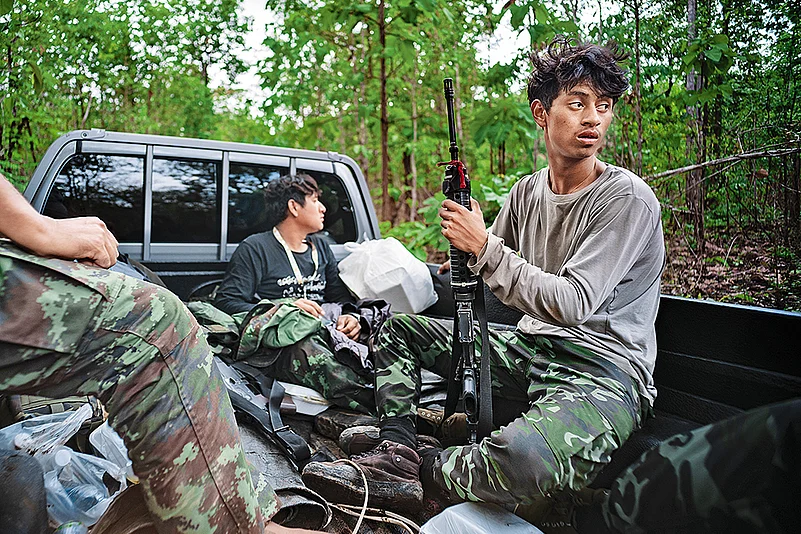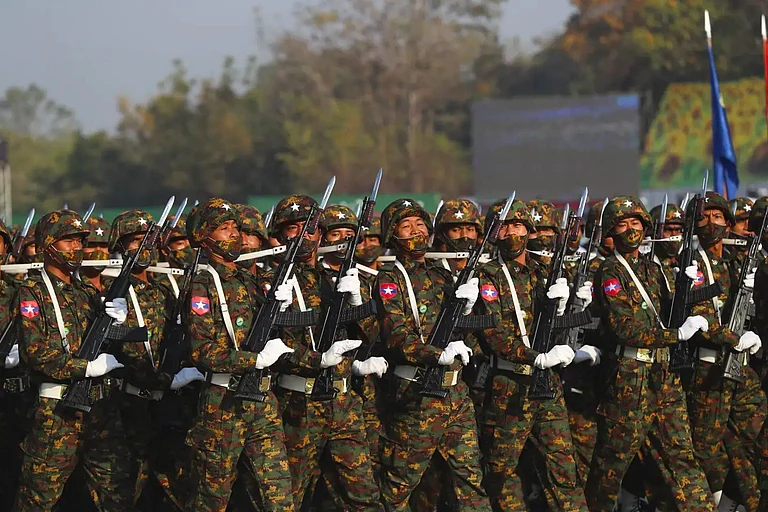In the civil war that has been raging in Myanmar between the military junta and the people who are fighting for a return to democracy, New Delhi has publicly and steadfastly backed the generals. In the light of what happened in Bangladesh, and the fact that the military has since last year been gradually losing territory, is it time for India to review its policy?
The opposition groups, made up of ethnic and armed organisations, now control 60 per cent of Myanmar’s territory. The National Unity Government (NUG) is the political face of the movement. Like Bangladesh, Myanmar borders India’s sensitive north-eastern region. India shares a 1,643-km open border with Myanmar that impinges on its security and strategic interests. The situation in Myanmar is much more complicated than Bangladesh and has to be handled on multiple fronts.
“The events in Bangladesh hold a critical lesson for India—to not put all its eggs in one basket. In Myanmar’s case, that means not investing in just the junta—which is more unpopular than ever before in recent history—but building strong relationships with the pro-democracy side,” says analyst Angshuman Choudhury. “This is especially because the junta’s leadership, with Min Aung Hlaing at the top, is reportedly facing serious dissensions from within its own ranks. This could further weaken the junta, which is already struggling to hold on to territory beyond the Bamar-dominated core. India would find itself on the wrong side of things, much like in Bangladesh, if it continues to warm up to this incapable and brutal coup regime,” says Choudhury.

The civil war has been raging behind the bamboo curtain for the last three years in one of the world’s most isolated countries. The military junta did not respect the election results of 2020, where Nobel Laureate Aung San Suu Kyi’s National League for Democracy (NLD) was declared the winner. On February 1, 2021, as the newly-elected members were to be sworn in, they were arrested. Suu Kyi was among the first to be put in jail. The military, already a major force in the country, took full control, stripped people’s fundamental rights and cracked down on protesters and democracy activists. Hlaing, as the chairman of the State Administration Council, has ruled Myanmar since seizing power in the 2021 coup. But with the military unable to control large swathes of the outlaying provinces in the country, Hlaing finds himself in a spot of bother. Losing territory has also led to rumblings within the powerful ruling clique.
Sheikh Hasina learnt the hard way that the yearning for democracy sometimes gives ordinary people extraordinary courage. Like the student protesters in Bangladesh, in Myanmar too, people were ready to take on the brutal military.

“Activists belonging to the younger generations, especially Gen Z, are playing a key role in reshaping the politics, both in Bangladesh and in Myanmar. This generation does not see India’s persistent engagement with legacy leaders, like Hasina and Hlaing, favourably,” Choudhury points out.
The common perception in Myanmar is that New Delhi is not merely supporting the generals, but aiding the military with equipment. Whether the equipment is lethal or not, is irrelevant. The fact is that it weaves into the narrative of India siding with an anti-democratic regime.
But analysts believe that Bangladesh and Myanmar are very different and should not be judged by the same yardstick. “The situation in Myanmar is both complex and confusing. The fighting is between the ethnic armies and the military,” says S D Muni a former professor at the Jawaharlal Nehru University, who keeps track of the South Asian region. “There is no viable force that India can back at the moment. So like other countries, we are following the ASEAN lead,” he says. But India can work with elected members of parliament who were prevented by the regime from taking oath, he adds.
India shares a 1,643-km open border with Myanmar that impinges on its security and strategic interests. The situation in Myanmar is much more complicated than Bangladesh and has to be handled on multiple fronts.
“India is already in touch with the NUG, but that is not enough,” says Rajiv Bhatia, former ambassador to Myanmar. As there is no public acknowledgement of the engagement, little is known about it. Moreover, at what level is the engagement, is an important point. It makes sense only if the contact is with the shadow foreign minister or some such other unity government functionary. The NUG represents the majority Bamar or Burman people who make up the largest ethnic and linguistic group living in the country, and India cannot afford to ignore them. “What is needed is NUG plus,” Bhatia explains. He is referring to the ethnic groups that live along the Indian border like the Kachins, Chins and the people in Rakhine state. “We need to have contact with these groups to ensure effective border management,” adds Bhatia. There have already been accusations in Manipur of foreign nationals from Myanmar crossing over and settling in forest lands of the state. In Mizoram, despite the Union home ministry’s orders that people fleeing the fighting between the Bamar army and the ethnic Chin rebels should not be allowed entry into Mizoram, the state government has hosted around 5,000 Chin refugees who have relations in Mizoram, and have crossed over to escape the fighting.
In the past, New Delhi had backed the pro-democracy movement in Myanmar. After Suu Kyi was placed under house arrest in 1989, New Delhi, like many other nations, refused to engage with the military rulers. During the crackdown of the pro-democracy activists, thousands of party workers took refuge in India. China gained from India’s decision to withdraw from Myanmar, filling the vacuum and spreading its wings across the country. In 1991, when Narasimha Rao came to power, the concern about Chinese presence resulted in a policy correction. New Delhi reached out to the military and opted for pragmatic self-interest.
That policy continued through A B Vajpayee’s tenure, though his defence minister, George Fernandes, allowed the pro-democracy activists to run a newspaper from his official residence in New Delhi. Successive governments continued wooing the junta to keep China at bay. After Suu Kyi was released from house arrest in 2009, she publicly criticised India for not supporting the pro-democracy movement in her country. When the Narendra Modi government did not allow Rohingya refugees to enter the country, the generals were pleased.
Today, the situation is somewhat different. While the ethnic armies have got the upper hand in the outlaying provinces of Myanmar, it would not be easy to take over the larger cities and the capital where the military is much stronger. At least 8,000 civilians have been killed in the conflict. About 2.3 million displaced. The regime has bombed the strongholds of the ethnic armies and killed civilians.
China is playing both sides—while backing the military, it has also flirted with ethnic armies. Beijing began engaging with the ethnic forces to clean up the border warlords that had killed several of its citizens and cheated them of large sums of money.
The situation in Myanmar continues to worry both India and China. For now, New Delhi will have to manage to live with a troubled neighbour. But it must not go against the will of the people.
Behind The Burma Curtain

















